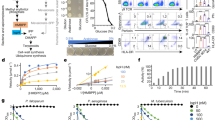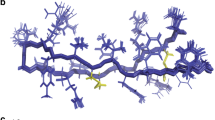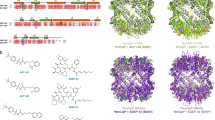Abstract
Here we show that a new class of antibiotics—acyldepsipeptides—has antibacterial activity against Gram-positive bacteria in vitro and in several rodent models of bacterial infection. The acyldepsipeptides are active against isolates that are resistant to antibiotics in clinical application, implying a new target, which we identify as ClpP, the core unit of a major bacterial protease complex. ClpP is usually tightly regulated and strictly requires a member of the family of Clp-ATPases and often further accessory proteins for proteolytic activation. Binding of acyldepsipeptides to ClpP eliminates these safeguards. The acyldepsipeptide-activated ClpP core is capable of proteolytic degradation in the absence of the regulatory Clp-ATPases. Such uncontrolled proteolysis leads to inhibition of bacterial cell division and eventually cell death.
This is a preview of subscription content, access via your institution
Access options
Subscribe to this journal
Receive 12 print issues and online access
$209.00 per year
only $17.42 per issue
Buy this article
- Purchase on Springer Link
- Instant access to full article PDF
Prices may be subject to local taxes which are calculated during checkout





Similar content being viewed by others
References
Levy, S. & Marshall, B. Antibacterial resistance worldwide: causes, challenges, responses. Nat. Med. 10, S122–S129 (2004).
Infectious Diseases Society of America. Bad bugs, no drugs. As antibiotic discovery stagnates, a public health crisis brews. IDSA <http://www.idsociety.org/pa/IDSA_Paper4_final_web.pdf> (2004).
Hiramatsu, K. et al. New trends in Staphylococcus aureus infections: glycopeptide resistance in hospital and methicillin resistance in the community. Curr. Opin. Infect. Dis. 15, 407–413 (2002).
Weigel, L. et al. Genetic analysis of a high-level vancomycin-resistant isolate of Staphylococcus aureus. Science 302, 1569–1571 (2003).
Appelbaum, P.C. Resistance among Streptococcus pneumoniae: Implications for drug selection. Clin. Infect. Dis. 34, 1613–1620 (2002).
Michel, K.H. & Kastner, R.E. A54556 antibiotics and process for production thereof. US patent 4492650 (1985).
Hardy, C. & Cozzarelli, N. Alteration of Escherichia coli topoisomerase IV to novobiocin resistance. Antimicrob. Agents Chemother. 47, 941–947 (2003).
Tsubery, H., Ofek, I., Cohen, S., Eisenstein, M. & Fridkin, M. Modulation of the hydrophobic domain of polymyxin B nonapeptide: effect on outer-membrane permeabilization and lipopolysaccharide neutralization. Mol. Pharmacol. 62, 1036–1042 (2002).
Maurizi, M.R., Thompson, M.W., Singh, S.K. & Kim, S.H. Endopeptidase Clp: ATP-dependent Clp protease from Escherichia coli . Methods Enzymol. 244, 314–331 (1994).
Wang, J., Hartling, J.A. & Flanagan, J.M. The structure of ClpP at 2.3 A resolution suggests a model for ATP-dependent proteolysis. Cell 91, 447–456 (1997).
Msadek, T. et al. ClpP of Bacillus subtilis is required for competence development, motility, degradative enzymes synthesis, growth at high temperature and sporulation. Mol. Microbiol. 27, 899–914 (1998).
Porankiewicz, J., Wang, J. & Clarke, A.K. New insights into the ATP-dependent Clp protease: Escherichia coli and beyond. Mol. Microbiol. 32, 449–458 (1999).
Thompson, M.W., Singh, S.K. & Maurizi, M.R. Processive degradation of proteins by the ATP-dependent Clp protease from Escherichia coli. Requirement for the multiple array of active sites in ClpP but not ATP hydrolysis. J. Biol. Chem. 269, 18209–18215 (1994).
Woo, K.M., Chung, W.J., Ha, D.B., Goldberg, A.L. & Chung, C.H. Protease Ti from Escherichia coli requires ATP hydrolysis for protein breakdown but not for hydrolysis of small peptides. J. Biol. Chem. 264, 2088–2091 (1989).
Schlothauer, T., Mogk, A., Dougan, D.A., Bukau, B. & Turgay, K. MecA, an adaptor protein necessary for ClpC chaperone activity. Proc. Natl. Acad. Sci. USA 100, 2306–2311 (2003).
Bandow, J.E., Brötz, H., Leichert, L.I., Labischinski, H. & Hecker, M. Proteomic approach to understanding antibiotic action. Antimicrob. Agents Chemother. 47, 948–955 (2003).
Hecker, M., Schumann, W. & Völker, U. Heat-shock and general stress response in Bacillus subtilis . Mol. Microbiol. 19, 417–428 (1996).
Gerth, U. et al. Fine-tuning in regulation of Clp protein content in Bacillus subtilis . J. Bacteriol. 186, 179–191 (2004).
Kock, H., Gerth, U. & Hecker, M. MurAA, catalysing the first committed step in peptidoglycan biosynthesis, is a target of Clp-dependent proteolysis in Bacillus subtilis . Mol. Microbiol. 51, 1087–1102 (2004).
Fritsche, T., Sader, H., Cleeland, R. & Jones, R. Comparative antimicrobial characterization of LBM415 (NVP PDF-713), a new peptide deformylase inhibitor of clinical importance. Antimicrob. Agents Chemother. 49, 1468–1476 (2005).
Kwon, H. et al. Effect of heat shock and mutations in ClpL and ClpP on virulence gene expression in Streptococcus pneumoniae. Infect. Immun. 71, 3757–3765 (2003).
Kwon, H. et al. The ClpP protease of Streptococcus pneumoniae modulates virulence gene expression and protects against fatal pneumococcal challenge. Infect. Immun. 72, 5646–5653 (2004).
Hensel, M. et al. Simultaneous identification of bacterial virulence genes by negative selection. Science 269, 400–403 (1995).
Anagnostopoulos, C. & Spizizen, J. Requirements for the transformation in Bacillus subtilis . J. Bacteriol. 81, 741–746 (1961).
Acknowledgements
We acknowledge several scientists at Bayer HealthCare: U. Pleiss for labeling of the ADEP-crosslinker, S. Seip and J. Bennet-Buchholz for determination of the ADEP structure, A. Mayer-Bartschmid and M. Brüning for fermentation of the natural products, B. Wieland for help with purification of native ClpP, E. Sander and I. Loof for pathological analysis of the mice during the toxicology study and G. Schiffer, C. Freiberg, N. Brunner, D. Haebich and K. Ziegelbauer for discussions. We thank T. Msadek (Institute Pasteur, Paris) for strains QB4916 and QB4756, H. Nikaido (University of California, Berkeley) for E. coli HN818 and R. Bartenschlager (University of Heidelberg) for the HUH7 cell line. U. Gerth (University of Greifswald) is acknowledged for providing the His-ClpP producer strain, mutants BUG2 and BUG7, as well as for testing the activity of ADEP 1 against two strains, PS28 and PS46, provided by A.L. Sonenshein (Tufts University, Boston). We are furthermore indebted to T. den Blaauwen and N. Nanninga (University of Amsterdam) and to M. Hecker (University of Greifswald) for discussions. H.-G.S. acknowledges financial support by the Deutsche Forschungsgemeinschaft and the BONFOR program.
Author information
Authors and Affiliations
Corresponding author
Ethics declarations
Competing interests
Heike Brötz-Oesterhelt, Dieter Beyer, Hein-Peter Kroll, Rainer Endermann, Christoph Ladel, Werner Schroeder, Berthold Hinzen, Siegfried Raddatz, Holger Paulsen, Kerstin Henninger and Harald Labischinski are employees of Bayer HealthCare AG.
Supplementary information
Supplementary Fig. 1
Nonspecific adsorption of B. subtilis cell lysate (extract out of 0.2 g wet weight) to blank NHS-Sepharose (1 ml column volume). (PDF 58 kb)
Supplementary Fig. 2
Growth of E. coli during overexpression of ClpP from B. subtilis (upper two panels) or its own ClpP (lower two panels). (PDF 92 kb)
Supplementary Fig. 3
Proteome analysis. (PDF 206 kb)
Supplementary Table 1
Effect of ADEPs on eukaryotic cell lines in vitro. (PDF 19 kb)
Supplementary Table 2
Effect of inactivation of all members of the Clp gene family in B. subtilis on the activity of the ADEPs. (PDF 34 kb)
Rights and permissions
About this article
Cite this article
Brötz-Oesterhelt, H., Beyer, D., Kroll, HP. et al. Dysregulation of bacterial proteolytic machinery by a new class of antibiotics. Nat Med 11, 1082–1087 (2005). https://doi.org/10.1038/nm1306
Received:
Accepted:
Published:
Issue Date:
DOI: https://doi.org/10.1038/nm1306
This article is cited by
-
Proteolysis dependent cell cycle regulation in Caulobacter crescentus
Cell Division (2022)
-
Anti-infective therapy using species-specific activators of Staphylococcus aureus ClpP
Nature Communications (2022)
-
Teixobactin kills bacteria by a two-pronged attack on the cell envelope
Nature (2022)
-
Progression of the late-stage divisome is unaffected by the depletion of the cytoplasmic FtsZ pool
Communications Biology (2021)
-
Small molecule inhibitors of the mitochondrial ClpXP protease possess cytostatic potential and re-sensitize chemo-resistant cancers
Scientific Reports (2021)



